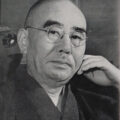Lessons from Inamori Management Philosophy: The Manager Who Embodied Dynamic Duality

Inamori Kazuo (1932-2022), founder of Kyocera and KDDI, photographed in 2011
CC BY-SA 3.0, Science History Institute via Wikimedia Commons
What is the essence of Inamori Kazuo’s Management Philosophy? Prof. Nonaka Ikujiro, a global authority in organizational management and a research advisor at the Ritsumeikan Inamori Philosophy Research Center, shares his perspective.
Nonaka Ikujiro, Professor Emeritus, Hitotsubashi University
A manager who recognized the importance of “empathy”

Prof. Nonaka Ikujiro
Japan’s knowledge power used to be unsurpassed in the world. However, it has become sluggish, especially in the last 30 years. I believe that the key to its revival lies in a “humanizing strategy,” meaning a “humanity-centric” strategy based on empathy, and this was something brilliantly put into practice in the management philosophy of Inamori Kazuo (1932–2022), who regrettably passed away on August 24, 2022.
One typical theory of strategy is Michael Porter’s theory of competitive strategy. The method starts by analyzing the structure of the market to compose corporate strategy. This scientific and analytical strategy theory has been widespread in Japan in recent years as well. The Western philosophical tradition has been about objectifying and analyzing phenomena since René Descartes (1596–1650) in what may be termed a “head first” scientific methodology. I studied business administration and obtained a degree in the United States, where I was taught mainly that “management is science,” with the MBA (Master of Business Administration) being a typical example.
By contrast, a humanizing strategy and Inamori management, which I will get to, emphasize not only such analytical methods but also direct experience as the starting point. Descartes said, “I think, therefore I am” (Cogito, ergo sum); however, we can find meanings only in what is happening right in front of our eyes. The meaning arises not just because we think in our heads, but because we feel the reality with our whole body. In other words, we cannot make sense of the world without our bodily senses.
A century ago, Edmund Husserl (1859–1938), well-known as the founder of phenomenology, advocated for the importance of direct experience. How could the rational Europeans engage in an irrational and immoral war like World War I? Husserl, a mathematician and a philosopher, concluded that the “mathematization of the lifeworld” was the biggest culprit. He warned of the danger of dividing the world into subjectivity and objectivity and prioritizing numbers and logic exclusively through science. Husserl suggested that the essence of the world is not based on “quantity” but on “quality,” and that we must first feel the world through direct experience. In other words, “feel first to think.”
The important thing here is “empathy.” The value creation (innovation) process described in my Organizational Knowledge Creation Theory also begins with empathy. The starting point for creating knowledge throughout an organization is to empathize with others, things, and the environment through direct experience. Enriched in this way, tacit knowledge of individuals is shared through dialogue, made into conceptualized, explicit knowledge, and is elevated into collective and organizational knowledge by being freely combined with all kinds of knowledge. This process is based on the difference between “you and me.” Our subjectivities, which arise from personal experiences, are exposed with each other and transformed into what Husserl calls “intersubjectivity,” the subjectivity of “us.” The cultivation of intersubjectivity is an opportunity to create new meaning and value as an organization. In other words, empathy is the source of innovation, and you could say that it is the second person who mediates between the “individual subjectivity = first person” and the “organizational objectivity = third person.”
To create intersubjectivity, people with different subjectivities and experiences must come face to face with each other and thoroughly express their subjectivities without compromise or defensiveness. This type of intellectual combat was systematized in the “compa” that Inamori started during his time at Kyocera. Compa refers to a place where managers, employees, and colleagues sit on tatami mats with a drink in their hands and open up to talk sincerely about their professional concerns, work styles, and life philosophy. In general, everyone participates, and I have participated at the Kagoshima Kokubu Plant. It was frank intellectual combat where everyone exposed their minds while eating from the same pot. The ethos of the compa was also manifested in a common practice such as pouring alcohol for each other rather than helping yourself. Compa was also introduced in the revival of JAL (Japan Airlines).
The essence of Inamori management is about creating autonomous organization where employees form “intersubjectivity” that transcends “ego-centric subjectivity” for the realization of one big vision.
Japan companies have lost their great causes
The origin of Inamori’s management philosophy is a vision with a noble cause, namely “altruism” or “for the good of the world.” He picked “Keiten aijin” (respect the divine and love people), which is derived from the famous Nanshu-o ikun (The Teachings of the Late Nanshu) by Saigo Takamori (1828–77) as a corporate motto. When Kyocera’s Shiga Plant (currently Shiga Gamo Plant) opened in 1963, he showed the employees the path to the creation of a new future with the following description of the Inamori management philosophy.
“With ‘Keiten aijin’ as our motto, Kyocera’s spirit is a conviction to dedicate ourselves to the cultivation of our human character and work. We are constantly striving to improve our technology, pioneering the unknown, loving to work on things that others can’t make, demonstrating creativity, and making the impossible possible. This is a place where we can talk openly and discuss with each other, so that the cultivated character and energy of each person breathes humanity into Kyocera corporation. Each person is unified into Kyocera to become one, and the true nature of Kyocera is then finally manifested. Let the joys of those working with us be our own joy, and their sorrows be our sorrows. Consider Kyocera’s prosperity our own prosperity and Kyocera’s suffering our own suffering. We will feel enthusiasm and hope to resolve any challenges ahead. We believe in each other, build heart-to-heart bonds first, and feel pride and infinite joy as Kyocera people. In the remote hills of Shimogamo Akasaka (currently Higashiomi city) in Shiga Prefecture, I want to create a great Kyocera utopia.”
I think of management as a “way of life,” but a way of life in management has an aspect of art, as it can only be expressed through stories. Inamori’s message wonderfully demonstrates the “way of life” of Kyocera and its employees as well as their strong determination to realize its story.
On the other hand, Japanese companies today are all about analytical and scientific approaches, and I cannot help but think that the “way of life” as a company or person is ignored. “Why we exist and how we shall live our lives.” Without such raison d’être, human beings cannot act independently, and organizations will not be united.
In recent years, “purpose management” has become popular, probably to rectify this managerial trend. To put it simply, purpose management is the idea that a company’s raison d’être should be demonstrated in society, and if you look at the Japanese business history, you find many managers like Matsushita Konosuke (1894–1989), Honda Soichiro (1906–1991), Morita Akio (1921–1999) and Ibuka Masaru (1908–1997) who were conscious of social significance. They all evolved their companies by constantly asking themselves “What are we living for?” When Japan lost the war, we continued to think about what Japan should be, and by putting that into practice, the capacity of Japanese people was unleashed, thus causing high economic growth. I would say that Inamori is one of the managers in that tradition.
Peter Drucker was the first to use the word “purpose” in business administration, and he explained it by using the metaphor of the three bricklayers. A guy asked each of them, “Why are you laying bricks?” The first bricklayer answered, “because my boss told me to.” The second replies, “to earn money.” However, the third said, “I’m building a cathedral that lasts for generations.” That’s how the story goes. Japanese managers have traditionally been the “third man” who values the company’s social significance and common good, but now they seem to be trapped under the spell of Michael Porter. The now so popular purpose management must not end up being another failing trend.
Not “binary opposition” but “dynamic duality”
It’s easy to argue that a company cannot pursue altruism and profit together so you must choose one. Discussions about global environmental issues in recent years have likewise often stood on the premise that social contribution and corporate growth are incompatible. In other words, altruistic practice and profit-making are viewed as a binary opposition. Inamori management aims at achieving growth by pursuing altruism as well as profit as a singular endeavor. I call this “dynamic duality” management, which refers to the way of management that positions two seemingly contradictory matters in a grand vision, discerns their essence in motion, integrates them through contemplation, and transcend the contradiction to create something more holistic and new.
Inamori’s amoeba management embodies this concept of dynamic duality. Amoeba management is a mechanism to encourage all employees to participate in management by dividing the organization into small teams called “amoebas.” Each leader of amoebas manages their own small team like a manager. It is an excellent accounting system, and by aiming to create small teams that can easily modify their shape, like amoebas, it can respond flexibly and promptly to market changes. By giving them autonomy, the groups also becomes able to tackle unseen and complex problems. The amoeba was an organizational mechanism for human capability development in a decentralized manner.
The point of this system is that the members of an amoeba learn to think of their life philosophy. If each person pursues only profit for their own amoeba, the organization becomes dysfunctional. There must be a balance between altruism and selfishness. Inamori management was able to do this because each individual learns to live by their life philosophy. Unlike Western-style organizational management, amoeba management does not link performance and reward but sets organizational evaluation criteria to encourage each team to achieve both altruism and profit-making. This evaluation system reflects Inamori’s philosophy that human potential should always be directed toward good things.
Western dialectics have the concept of “thesis-antithesis-synthesis,” which considers “thesis” and “antithesis” as contradictory opposites that are then elevated to a higher level of “synthesis.” From the perspective of dynamic duality, however, intuition and analysis, or tacit knowledge and explicit knowledge, are seen as the opposite ends of a continuum, and by interacting with one another, the aim is to transcend the contradiction and create new meaning. In that sense, it can be called transformation.
Of course, getting to transformation isn’t easy. That is why it is necessary to create new knowledge via intellectual combat through empathy. In any case, Inamori emphasized altruism and clearly pursued profit, achieving a balance between the two. The principle is “maximizing revenues and minimizing expenses,” for which Inamori management is famous, and his conviction was clearly expressed when JAL Chairman Ueki Yoshiharu said “Through practice, it was thoroughly drummed in that we should be making profit” (The Nikkei, September 4, 2022).
Need of Inamori management philosophy for new capitalism
In recent times, there have been more opportunities to discuss the state of capitalism. In 2019, I visited Adam Smith’s former home (Panmure House) in Scotland and attended a conference titled “The New Enlightenment: Reshaping Capitalism and the Global Order in a Neo-Mercantilist World.” It was organized by David Teece (Professor of the Business School, University of California, Berkeley), John Kay (Visiting Professor, London School of Economics), and Niall Ferguson, a historian. The focal discussion was that we must go back to the basics and think about capitalism based on human ethics.
Before writing The Wealth of Nations, Adam Smith authored The Theory of Moral Sentiments, where he focused on human sympathy. Smith’s view was that social order is maintained because humans have sympathy, and from that point of view, market fundamentalism and shareholder capitalism, which pursue only corporate profits without consideration for others, violates his idea on which the economic activities should be based.
In the last few years, “stakeholder capitalism” has been advocated, wherein the company should consider all stakeholders such as employees, business partners, customers, and local communities, but this is something that Japanese management has long been all about. Moreover, “human capital management” has recently regained attention, but humans are not capital or resources. I feel like we might have ended up neglecting the fact that human beings are “active agents who create value for the future.”
Stories that speak of a “way of life” will be important for managers in the coming years. Humanizing strategy defines “strategy as a story of how to create the future,” and this story has two pillars. One is the way of life of the company, that is, the path to realizing its vision, and the other is action guidelines. I describe these as “plot” and “script,” respectively, but the first thing to do is to draw up a plot that excites employees and customers. However, no matter how great a plot you may have, nothing will happen if you cannot put it into practice. So, with the raw expressions that everyone can buy into, we should present action guidelines, or a script, to carry out the plot.
In Inamori’s words, the “Kyocera philosophy” is a clear guideline that summarizes how to put management philosophy into practice in 78 categories. For example, both “always be creative in your work” and “be the center of the vortex” are concise and intuitive guidelines. Most of them are based on the teachings of Inamori’s mother and reflect his desire to value what is right as a person.
The military song suddenly sung during a discussion
Inamori was a genius wordsmith with excellent humanity, which is probably why he was able to become a leader who moves people into action. Finally, to share one personal memory of mine, in 2015, as we were talking at Weekly Diamond on the subject of the JAL reconstruction, the atmosphere was awkward at first, but when we resumed in the afternoon after a lunch break, Inamori suddenly started singing, “With the loud sound of the engine, Hayabusa goes to the ends of the clouds…” It was a military song titled Kato hayabusa sento-tai (Colonel Kato’s Falcon Squadron), and I also learned it at the National Defense Academy, so I recognized it right away.
I was surprised, but once Inamori had finished singing, I asked “Kato hayabusa sento-tai, isn’t it?” to which he responded, “That’s right. In fact, there was a JAL compa yesterday.” At that time, it was customary to end compa attended by Inamori by singing a military song all together, and it appeared that Kato hayabusa sento-tai had been added to the repertoire at JAL. From there, the atmosphere became relaxed, and as a result, the discussion turned out exceedingly substantial.
Moreover, Inamori is famous for his deep care for what is happening on the ground as much as in the office, which is probably why he could intuitively understand the essence of the situation. Essence is the meaning behind individual phenomena, but reality changes from moment to moment. A leader cannot grasp the essence unless the leader moves and feels the reality first hand and interacts with the people at the place of action. Of course, the employees are always watching what a leader is doing. Thus, Inamori was particularly strict with the management members. To quote JAL Chairman Ueki’s recollections to The Nikkei, “He (Inamori) scolded executives in the harshest way, going surprisingly far. It was so much that they could barely stand up after the meeting. He would scold them in front of everyone in a meeting.” Having recalled this, he said, “but it was a way of scolding with genuine passion and love, and it was because of Inamori’s virtue that we were all able to keep up.”
Of course, managers are constantly forced to make decisions, and if they do not balance warmth and ruthlessness well, their business would face tremendous difficulty. Even if those around you oppose you, you sometimes have to act decisively based on your beliefs. You have to listen sincerely to the words of every employee and engage in intellectual combat. Inamori Kazuo embodied dynamic duality management by neither resorting to binary opposition nor being moderate. He stuck to “what is right” as a person. His approach and attitude to management should provide many hints for managers today.
Translated from “Imakoso ‘Inamori Keiei Tetsugaku ni manabe: Nikodotai wo taigenshita keu na keieisha’ (Learn from the “Inamori Management Philosophy”: The Rare Managers Who Embody Dynamic Duality),” Voice, November 2022, pp. 104-111. (Courtesy of PHP Institute) [February 2023]
Keywords
- Nonaka Ikujiro
- Hitotsubashi University
- Ritsumeikan Inamori Philosophy Research Center
- Organizational Knowledge Creation Theory
- Inamori Kazuo
- Inamori Management Philosophy
- Kyocera
- Kyocera philosophy
- KDDI
- JAL
- management
- empathy
- Michael Porter
- Edmund Husserl
- subjectivity
- intersubjectivity
- compa
- Keiten aijin
- heart-to-heart
- altruism
- dynamic-duality management
- amoeba management
- Adam Smith




